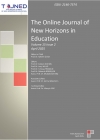TOJNED - Volume 3 - Issue 1 - January 2013
 Critical Thinking Level of Biology Classroom Survey: Ctlobics
Critical Thinking Level of Biology Classroom Survey: Ctlobics Atilla ├āŌĆĪimer, Melih Timu├ā┬¦in, Mehmet Koko├ā┬¦
Abstract: Within this study, Critical Thinking Level of Biology Classroom Survey (CTLOBICS) was developed to determine to what extend Biology classroom environment supports Critical Thinking Culture. The survey was developed by following the scale development model by McMillan & Schumacher (2010). The theoretical framework of the study was adapted from Critical Thinking Strategies (Paul et al., 1990). The item pool of the survey was composed of these strategies expressed in sentences and a 59-item- scale was prepared along with the collected expert opinions. The pilot study was conducted with 387 9th, 10th and 11th grade students from two different secondary schools located in Trabzon in Turkey. The survey was finalized after Exploratory and Confirmatory Factor Analyses. The Survey has 32 items and 5 factors (Affective Critical Thinking Skills, General Thinking Skills, Basic Critical Thinking Skills, Associating with Real Life, Reasoning Skills). The inner consistency coefficient α of the scale was calculated as 0,92.
 Experiences of First Day of Teaching
Experiences of First Day of Teaching Zeynep Akda├ä┼Ė, ├āŌĆĪi├ä┼Ėdem Haser
Abstract: Purpose of this study is to investigate new teachers first day expectation, challenge and coping strategies. In order to investigate this phenomenon 16 pre-service early childhood education teachers studying at the same teacher education program were interviewed immediately before their graduation. Participating teachers started to teach at different cities in public schools. Then, researchers contacted with them at the end of the first semester they taught to have another interview. Moustakas s (1994) phenomenological analysis was utilized to analyze the data. Findings have revealed that pre-service teachers were aware of some problems that they would probably encounter in their first day of teaching such as crying children. Yet, teaching children who did not know Turkish or teaching 56 children in their first day were not exactly what they expect initially.
 GPSS Interactive Learning Environment
GPSS Interactive Learning Environment Villarreal Gonzalo L., De Giusti Marisa R., Texier Jos├ā┬®
Abstract: This work presents an open source web environment to learn GPSS language in Modeling and Simulation courses. With this environment, students build their models by selecting entities and configuring them instead of programming GPSS codes from scratch. Teachers can also create models so that students can apply, analyze and interpret results. Thus, it includes a simulation engine that stores snapshots of models as they are executed, and allows students to navigate through these snapshots. The environment may be combined with existing learning management systems.
 Graphical design elements that should be considered in computer based instruction
Graphical design elements that should be considered in computer based instruction Gamze Sarma├ģ┼Ė├ä┬▒k, ├āŌĆōzden I├ģ┼Ė├ä┬▒kta├ģ┼Ė, M. Volkan Co├ģ┼Ėkun
Abstract: Educational technology has emerged as a new field of education because the main means of having access to information has become technology. Thus, basic curriculums in all over the world have been in the process of restructuring; Classical teaching materials have been replaces by technological equipments (Smart boards, tablet PCs, mobile phones etc.) and new materials are designed for these technological tools (Course presentations, notes for distance education, educational software etc.). With the design of teaching materials for technological tools, graphical designs have become one of the most important ways of presenting information. Therefore, instructors should be knowledgeable about graphical design elements such as color of the background, the font used, the size of writing, the density of the text and the relationships among background color and font contrast etc. In this paper, the main focus is the elements to be considered in color selection and harmony which are among the principles of graphic design while designing computer based instruction materials.
 Has Anything Changed about the Teachers and the Teaching of High School Economics in 20 years?
Has Anything Changed about the Teachers and the Teaching of High School Economics in 20 years? Sudesh Mujumdar, Curtis Price, Gregory P. Valentine
Abstract: This paper surveys high school economics instruction in the state of Indiana (U.S.A). Compared to results from previous such surveys (1996, 2003), current survey results indicate the following: 1) A larger proportion of the instructors are female, younger and have more experience in teaching economics. This change in demographic profile (if reflected nationally) has important implications for the gender composition of economics-related professions and the gender-gap in earnings. 2) While computer-based instruction and classroom experiments have become somewhat more common, the lecture method is still the dominant pedagogy. This learning environment is far removed from the one that ├óŌé¼┼ōneomillenials├óŌé¼┬Ø are drawn to with not so salutary implications for the development of economics fluency. 3) The dual pursuit of personal finance literacy and economics literacy may be blunting the effectiveness of the latter competency.
 Social Learning Theories as tools for learning in an ICT educational system
Social Learning Theories as tools for learning in an ICT educational system Eugenia I. Toki, Jenny Pange
Abstract: The current study examines the effects of self-evaluation according to the nearest neighbour learning (NNL) method in the viewpoint of an undergraduate ICT subject in an Educational Department. The research questions addressed to students in order to evaluate whether they can identify their errors while working in small self-selected groups. This procedure indicates positive learning outcomes pointing that selfevaluation and NNL can contribute to an upward cycle of better learning with the potential of implementing them at all levels of the educational system.
 The Investigation of the Learning Styles of University Students
The Investigation of the Learning Styles of University Students Serap ├āŌĆōzba├ģ┼Ė
Abstract: The subject of this study is to determine the learning styles of university students and to compare it with gender, and departments differences. In this study, McVay Lynch Learning Style Inventory was used. The learning style inventory ,which consists of 59 articles and which is 3- Likert-Type scaled, includes three modes of learning called visual learning style, auditory learning style and kinesthetic learning style. According to the result of the study, it was seen that approximately half of the students learned visually. By observing the influence of the gender on the learning styles of the students, it was found out that, in visual learning, girls had obvious higher averages rather than boys in statistical terms. In addition, it was also noted that, neither the departments of the students nor the common effect of the gender nor the department does not affect the learning styles.
 The Relationship between Elementary Teacher Candidates Attitudes towards Problem Based Learning and Problem Solving Skills
The Relationship between Elementary Teacher Candidates Attitudes towards Problem Based Learning and Problem Solving Skills Mustafa Kahyao├ä┼Ėlu
Abstract: The purpose of this research is to determine the relation between elementary teacher candidates problem solving skills and attitudes towards problem based learning. Furthermore this research intend to determine if there is a significant difference in elementary teacher candidates problem solving skills and the attitudes towards problem based learning according to the variables of gender and their education program, or not. The research was carried out with a total of 199 third and fourth grade teacher candidates (100 female, 99 male) from Elementary Department of Faculty of Education at Siirt University in Turkey. It was used the ├óŌé¼┼ōProblem Solving Inventory├óŌé¼┬Ø which was developed by Heppner and Peterson (1982) and translated into Turkish by ├ģ┼Šahin, ├ģ┼Šahin and Heppner (1993) to determine the problem-solving skills of the teacher candidates and the ├óŌé¼┼ōProblem-Based Learning Attitude Scale├óŌé¼┬Ø which was developed by Turan and Demirel (2010) was used to determine their attitudes towards problem-based learning. In our research, it was calculated that the Cronbach alpha reliability coefficient of problem solving skills as .78 and the scale of attitudes towards problem based learning as .93. As a result of this research, the problem solving skills (M=87.91) and the attitudes towards problem based learning mean score (M=68.15) of elementary teacher candidates were found as medium level. It was found that there is no significant and negative relation between the elementary teacher candidates problem solving skills and attitudes towards problem based learning (r= .54; p>0.05).
 A Case Study on Teacher Instructional Practices in Mathematical Modeling
A Case Study on Teacher Instructional Practices in Mathematical Modeling Emine ├āŌĆōzdemir, Devrim ├ā┼ōzel
Abstract: There is in fact a tendency in several countries to include more mathematical modeling in curriculums. Mathematical curriculum in Turkey focuses on the principle of ├óŌé¼┼ōevery child can learn mathematics├óŌé¼┬Ø. From this perspective; more importance is given to modeling from the sixth grade to eighth grade mathematical curriculum. Accordingly, prospective mathematics teachers are required to be trained for preparing teaching environments appropriate for mathematical modeling. In this context, 33 prospective mathematics teachers are trained of mathematical modeling based teaching. 17 of them are selected randomly for modeling based teaching applications. Modeling based teaching carried out with modeling tasks developed by 17 prospective mathematics teachers at the end of training. This study is a case study of one of these 17 cases is selected for this study to provide descriptive information about instructional practices in mathematical modeling. Modeling task is applied on randomly selected 38 8th grade students in a practicing school. Both quantitative and qualitative data collection tools are used. The study presents information about instructional practices with data drawn from classroom observations and scoring rubrics.


